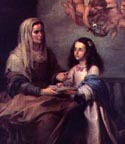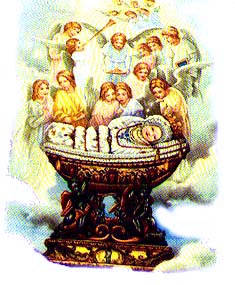DEVOTION TO THE HOLY INFANT MARY

Most Catholics are familiar with devotion to the Christ Child; at Christmas they venerate an image of Baby Jesus in the manger at Church, and perhaps they have said novenas to the Infant of Prague. But fewer Catholics know about devotion to the holy Virgin Mary in her infancy and childhood.
In fact, it is quite possible that many Catholics hardly give a thought to Mary's girlhood, except perhaps when viewing an image of Saint Anne with the child Mary by her side.
The Child Mary with Saint Anne, by Murillo
Yet devotion to "little Mary" is strong in Milan, Italy and Mexico City, Mexico, and it has a history rooted in Catholic hagiography and liturgy.
Early Sources
The New Testament is silent on Mary's birth and childhood; we first see her in the Gospel of Luke as a thirteen-year old girl betrothed to Joseph. But early Christians soon began to write extrabiblical accounts of Mary's early life.
The first of these is called the Protoevangelium of James. It was written around 120 AD, and discusses the events surrounding Mary's birth, childhood and betrothal, as well as embellishing on the biblical account of Jesus' birth.
From this book we learn that Mary's parents were named Joachim and Anne (Y'hoyakhin and Hannah in Hebrew). It also claims that Mary spent her childhood serving in the Temple of Jerusalem. Many of the stories contained in this and similar apocryphal writings influenced Catholic iconography and "mystical" accounts of Mary's life, such as Venerable Mary of Agreda's Mystical City of God and the revelations of Venerable Anne Catherine Emmerich.
Two later works of this nature, the Gospel of Pseudo-Matthew and the Nativity of Mary, draw heavily from the Protoevangelium (see links below for online versions of each of these works).
Feasts of Mary's Girlhood
The feast of the Nativity (Birth) of Mary (8 September) was first celebrated in the East by the Church of Jerusalem. In the fifth century a Byzantine church was erected there, on the spot where a tradition says the house of Sts. Anne and Joachim once stood. Many believe this to be the very place where the future Mother of the Messiah was conceived and born, and that church became a focal point for her birthday celebration. (The Western Church adopted this joyful feast by the seventh century).
Unfortunately, the original church was decimated during the Crusades. A new church was later built on that spot; this one still stands today and is a center of pilgrimage. Many people still go there to honor the child Mary.
If the Church celebrated Mary's birth on the eighth of September, then it only seemed natural that her conception would have occured nine months earlier, on the eighth day of December.
Thus Western Christians soon began to celebrate the Feast of Immaculate Conception on that very day. The Eastern Orthodox, who mostly reject the Immaculate Conception of Mary, celebrate 8 December as the "Conception of St. Anne", that is, the day on which Our Lady's mother conceived her.
The Feast of the Presentation of Mary (21 November) is very ancient, going back to the sixth century in the East. The West, however, did not adopt it until the fourteenth century. Since it celebrates Mary's alleged childhood service in the Temple (a concept derived from apocryphal literature, not Sacred Scripture), many popes were uncomfortable with it, and St. Pius V even suppressed it for the duration of his pontificate! It was reinstated by Sixtus V and remains on the Western liturgical calendar to this day. Among Eastern Christians it is one of the thirteen Great Feasts of the Church, often depicted in icons (see link below).
Maria Bambina in Italy
Milan boasts a beautiful little image of the Infant Mary, often referred to as "Maria Bambina".
 A Franciscan nun made this statue of the little Virgin out of wax sometime before 1730. She later gave it to others, and after passing as a gift through various hands it was finally given to the Sisters of Charity in Lovere, Italy. In 1876 they brought it to their motherhouse in Milan (where it has stayed ever since). By this time, the statue had become worn and gray.
A Franciscan nun made this statue of the little Virgin out of wax sometime before 1730. She later gave it to others, and after passing as a gift through various hands it was finally given to the Sisters of Charity in Lovere, Italy. In 1876 they brought it to their motherhouse in Milan (where it has stayed ever since). By this time, the statue had become worn and gray.
One of the nuns, Sister Josephine Woinovich, suffered from paralysis in her feet and arms. She could not get out of bed and was confined to the infirmary in great pain. In 1884, on the Feast of Mary's Nativity, Sister Josephine convinced the Mother General to leave the statue of Maria Bambina in her room overnight. The next morning Mother decided to take the little statue on a "tour" of the infirmary, to visit all the ill sisters there.
It so happened that a very devout novice named Guilia Macaro was in the infirmary, suffering from a serious condition which restricted her movement. When the image of Maria Bambina was brought to her bed, Guilia took it in her arms and fervently pleaded with Mary to ask God to heal her. Miraculously, Guilia was healed immediately!
The image was also suddenly transformed; it lost its old gray color and took on the color of living flesh, which it still has to this day! Sister Josephine was also ultimately cured through her devotion to Maria Bambina.
Because of these and many other miracles God has worked for those who venerate the statue, the Sisters of Charity in Milan are commmonly called the "Sisters of Maria Bambina".
Immaculate Little Mary in Mexico
As Providence would have it, an almost identical devotion developed separately in Mexico during the next century!
On 6 January 1840, the Feast of the Three Kings, Sister Magdalena knelt before a nativity scene in her convent in Mexico City, contemplating the Christ Child in the manger. She then had a thought: if we honor Jesus' infancy, why not that of His dear Mother? (She was not familiar with the "Maria Bambina" devotion across the sea in Italy).
Suddenly, a lovely little girl appeared before her, dressed like a tiny princess and reclining in thin air! Sister Magdalena immediately knew that this beautiful child was the Virgin Mary, appearing to her in the form of a baby.
The Infant Mary seemed to be telling her "I will grant great graces to whoever honors me in my infancy".
The astonished nun went to the abbess and told her of her vision and her desire to promote devotion to little Mary. The abbess did not quite share Sister Magdelena's excitement, so the devotion was not promoted right away. But Magdelena kept praying for God to bring it about.
Eventually, Sister Magedlena did receive permission to ask a local sculptor to fashion a statue of the Infant Mary. Once she received the image she began to spread the devotion. Many people experienced miracles through the intercession of little Mary, but others questioned the suitability of such a devotion (this often happens with new devotions; the Sacred Heart devotion had its critics as well).
The case was eventually brought before Pope Gregory XVI, who approved the devotion and even granted indulgences to those who practiced it! Thus the question of suitability was solved.
Over the decades God performed numerous miracles of healing for those who venerated this statue. Soon an order of nuns called the Slaves of the Immaculate Child was founded, as well as a priestly order, the Missionaries of the Nativity of Mary. Both are dedicated to the Immaculate Little Mary, and continue to work for the Church in Mexico and Puerto Rico.
Conclusion
Devotion to "little Mary" has great potential. Along with devotion to the Infant Jesus, it proclaims the beauty of innocence and childhood to a world which seems intent on destroying both! The devotion seems to appeal to little girls, who can see in Mary an example of consecrated girlhood. It can stand as a witness against female infanticide, still practiced in many parts of the world, and some have already begun to look upon the Infant Mary as a patroness of the Pro-Life cause!
The Catholic world is only beginning to tap the potential of this old-yet-new devotion. Perhaps one day all Catholics, and the whole world as well, will experience and benefit from the graces which fall from the tiny hands of Maria Bambina.
RELATED LINKS
When I first created these pages on the Holy Infant Mary, I could find nothing about this devotion on the Net. I am happy to say that I have since found two sites (possibly connected) discussing Maria Bambina! They are the first two links below. Blessed be God for promoting this precious devotion on the World Wide Web!
| Back: Virtual Shrine | Next: Prayers to Infant Mary | Marian Index | Site Index | Home Page | GeoCities |
 A Franciscan nun made this statue of the little Virgin out of wax sometime before 1730. She later gave it to others, and after passing as a gift through various hands it was finally given to the Sisters of Charity in Lovere, Italy. In 1876 they brought it to their motherhouse in Milan (where it has stayed ever since). By this time, the statue had become worn and gray.
A Franciscan nun made this statue of the little Virgin out of wax sometime before 1730. She later gave it to others, and after passing as a gift through various hands it was finally given to the Sisters of Charity in Lovere, Italy. In 1876 they brought it to their motherhouse in Milan (where it has stayed ever since). By this time, the statue had become worn and gray.
